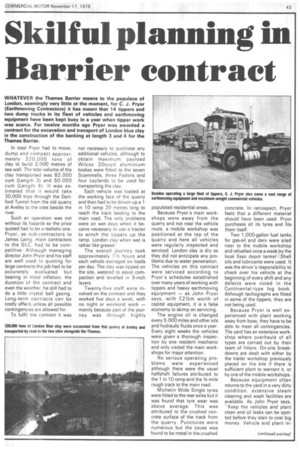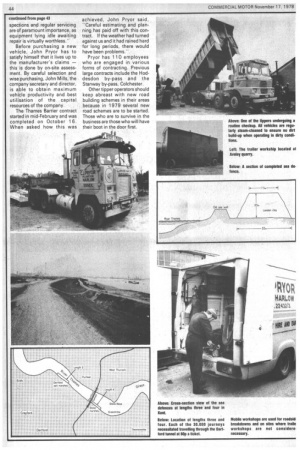Skilful planning in Barrier contract
Page 47

Page 48

If you've noticed an error in this article please click here to report it so we can fix it.
WHATEVER the Thames Barrier means to the populace of London, seemingly very little at the moment, for C. J. Pryor (Earthmoving Contractors) it has meant that 14 tippers and two dump trucks in its fleet of vehicles and earthmoving equipment have been kept busy in a year when tipper work was scarce. For twelve months ago Pryor was awarded a contract for the excavation and transport of London blue clay in the construction of the banking at length 3 and 4 for the Thames Barrier.
In total Pryor had to move, dump and compact approximately 320,000 tons of clay to build 2000, metres of sea wall. The total volume of the clay transported was 82,000 cum (Length 3) and 50,000 cum (Length 4). It was estimated that it would take 30,000 trips through the Dartford Tunnel from the old quarry at Aveley to the sites beside the river.
Such an operation was not without its hazards so the price quoted had to be a realistic one. Pryor, as sub-contractors to James Laing, main contractors to the GLC, had to be competitive. Although managing director John Pryor and his staff are well used to quoting for large contracts the job had to be accurately evaluated but bearing in mind inflation, the duration of the contract and even the weather, he still had to do a little crystal ball gazing. Long-term contracts can be costly affairs unless all possible contingencies are allowed for.
To fulfil the contract it was not necessary to purchase any additional vehicles, although to obtain maximum payload Wilcox 20cuyd aluminium bodies were fitted to the seven Scammells, three Fodens and four Leylands to be used for transporting the clay.
Each ,vehicle was loaded at the working face of the quarry and then had to be drlven up a 1 in 10 ramp 20 metres long to reach the track leading to the main road. The only problems were on wet days when it became necessary to use a tractor to winch the tippers up the ramp. London clay when wet is rather like grease!
The overall journey took approximately 11/2 hours and each vehicle averaged six loads per day. The clay was tipped on the site, watered to assist compaction and levelled in 9-inch layers.
Twenty-five staff were involved on the contract and they worked five days a week, with no night or weekend work — mainly because part of the journey was through highly
populated residential areas.
Because Pryor's main workshops were away from the quarry and not near the vehicle route, a mobile workshop was positioned at the top of the quarry and here all vehicles were regularly inspected and serviced. London clay is dry so they did not anticipate any problems due to water penetration. The vehicles on this contract were serviced according to Pryor's schedules established over many years of working with tippers and heavy earthmoving equipment — as John Pryor says, with E21/2m worth of capital equipment, it is a false economy to skimp on servicing.
The engine oil is changed every 5,000 miles and other oils and hydraulic fluids once a year. Every eight weeks the vehicles were given a thorough inspection by one resident mechanic and only visited the main workshops for major attention.
No serious operating problems were experienced although there were the usual halfshaft failures attributed to the 1 in 10 ramp and the 3/4-mile rough track to the main road.
Michelin Wide Single tyres were fitted to the rear axles but it was found that tyre wear was above average. This was attributed to the crushed concrete surface of the track from the quarry. Punctures were numerous but the cause was found to be metal in the crushed concrete. In retrospect, Pryor feels that a different material should have been used. Pryor purchases all its tyres and fits them itself.
Two 1,000-gallon fuel tanks for gas-oil and dery were sited near to the mobile workshop and refuelled once a week by the local Esso depot tanker. Shell oils and lubricants were used. It was the driver's responsibility to check over his vehicle at the beginning of every shift and any defects were noted in the Continental-type log book. Although tachographs are fitted in some of the tippers, they are not being used.
Because Pryor is well experienced with plant working away from base, they have to be able to meet all contingencies. The yard has an extensive workshop where overhauls of all types are carried out by their team of fitters. On-site breakdowns are dealt with either by the trailer workshop previously placed on the site if there is sufficient plant to warrant it, or by one of the mobile workshops.
Because equipment often returns to the yard in a very dirty condition, extensive steam cleaning and wash facilities are available. As John Pryor says, "Keep the vehicles and plant clean and oil leaks can be spotted before they start to cost big money. Vehicle and plant in spections and regular servicing are of paramount importance, as equipment lying idle awaiting repair is virtually worthless."
Before purchasing a new vehicle, John Pryor has to satisfy himself that it lives up to the manufacturer's claims — this is done by on-site assessment. By careful selection and wise purchasing, John Mills, the company secretary and director, is able to obtain maximum vehicle productivity and best utilisation of the capital resources of the company.
The Thames Barrier contract started in mid-February and was completed on October 16. When asked how this was achieved, John Pryor said, "Careful estimating and planning has paid off with this contract. If the weather had turned against us and it had rained hard for long periods, there would have been problems."
Pryor has 110 employees who are engaged in various forms of contracting. Previous large contracts include the Hoddesdon by-pass and the Stanway by-pass, Colchester.
Other tipper operators should keep abreast with new road building schemes in their areas because in '1979 several new road schemes are to be started. Those who are to survive in the business are those who will have their boot in the door first.






























































































































